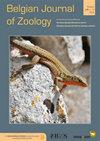Heather pollen is not necessarily a healthy diet for bumble bees
IF 1.1
4区 生物学
Q2 ZOOLOGY
引用次数: 0
Abstract
There is evidence that specialised metabolites of flowering plants occur in both vegetative parts and floral resources (i.e., pollen and nectar), exposing pollinators to their biological activities. While such metabolites may be toxic to bees, it may also help them to deal with environmental stressors. One example is heather nectar which has been shown to limit bumble bee infection by a trypanosomatid parasite, Crithidia sp., because of callunene activity. Besides in nectar, heather harbours high content of specialised metabolites in pollen such as flavonoids but they have been poorly investigated. In this study, we aimed to assess the impact of Crithidia sp., heather pollen and its flavonoids on bumble bees using non-parasitised and parasitised microcolonies fed either control pollen diet (i.e., willow pollen), heather pollen diet, or flavonoid-supplemented pollen diet. We found that heather pollen and its flavonoids significantly affected microcolonies by decreasing pollen collection as well as offspring production, and by increasing male fat body content while parasite exposure had no significant effect except for an increase in male fat body. We did not find any medicinal effect of heather pollen or its flavonoids on parasitised bumble bees. Our results provide insights into the impact of pollen specialised metabolites on heather-bumble bee-parasite interactions. They underline the contrasting roles of the two floral resources for bumble bees and emphasize the importance of considering both nectar and pollen when addressing medicinal effects of a plant for pollinators.对大黄蜂来说,石南花花粉不一定是健康的食物
有证据表明,开花植物的特殊代谢物存在于营养部分和花卉资源(即花粉和花蜜)中,使传粉者暴露于它们的生物活动中。虽然这些代谢物可能对蜜蜂有毒,但它也可能帮助它们应对环境压力。一个例子是石南花蜜,它被证明可以限制大黄蜂感染锥虫寄生虫,因为它的callen烯活性。除了花蜜外,石南花在花粉中还含有高含量的特殊代谢物,如类黄酮,但对它们的研究很少。在本研究中,我们旨在通过饲喂对照花粉饮食(即柳树花粉)、石楠花粉饮食或类黄酮补充花粉饮食的非寄生和寄生小蜂群,评估石楠花粉、石楠花粉及其类黄酮对大黄蜂的影响。我们发现,石楠花粉及其黄酮通过减少花粉收集量和后代产量,增加雄性脂肪体含量来显著影响小菌落,而暴露于寄生虫除了增加雄性脂肪体外,对小菌落没有显著影响。我们没有发现石南花粉及其类黄酮对被寄生的大黄蜂有任何药理作用。我们的研究结果为花粉专门代谢物对石南-大黄蜂-寄生虫相互作用的影响提供了见解。他们强调了两种花卉资源对大黄蜂的对比作用,并强调了在解决植物对传粉者的药用作用时考虑花蜜和花粉的重要性。
本文章由计算机程序翻译,如有差异,请以英文原文为准。
求助全文
约1分钟内获得全文
求助全文
来源期刊

Belgian Journal of Zoology
生物-动物学
CiteScore
1.90
自引率
0.00%
发文量
10
审稿时长
>12 weeks
期刊介绍:
The Belgian Journal of Zoology is an open access journal publishing high-quality research papers in English that are original, of broad interest and hypothesis-driven. Manuscripts on all aspects of zoology are considered, including anatomy, behaviour, developmental biology, ecology, evolution, genetics, genomics and physiology. Manuscripts on veterinary topics are outside of the journal’s scope. The Belgian Journal of Zoology also welcomes reviews, especially from complex or poorly understood research fields in zoology. The Belgian Journal of Zoology does no longer publish purely taxonomic papers. Surveys and reports on novel or invasive animal species for Belgium are considered only if sufficient new biological or biogeographic information is included.
 求助内容:
求助内容: 应助结果提醒方式:
应助结果提醒方式:


